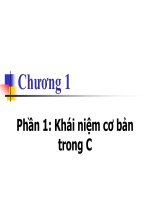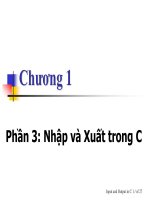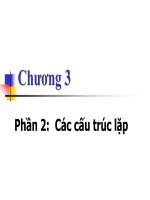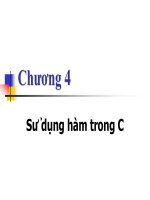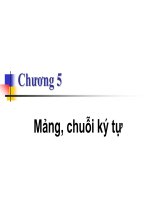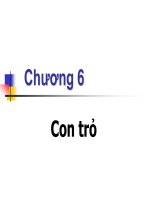Giáo trình C++ - Ngành CNTT - Part 01
Bạn đang xem bản rút gọn của tài liệu. Xem và tải ngay bản đầy đủ của tài liệu tại đây (1 MB, 61 trang )
Copyright © 2007 Pearson Education, Inc. Publishing as Pearson Addison-Wesley
Chapter 1
Introduction to Computers and
C++ Programming
Slide 1- 3
Copyright © 2007 Pearson Education, Inc. Publishing as Pearson Addison-Wesley
Overview
1.1 Computer Systems
1.2 Programming and Problem Solving
1.3 Introduction to C++
1.4 Testing and Debugging
Copyright © 2007 Pearson Education, Inc. Publishing as Pearson Addison-Wesley
1.1
Computer Systems
Slide 1- 5
Copyright © 2007 Pearson Education, Inc. Publishing as Pearson Addison-Wesley
Computer Systems
A computer program is…
A set of instructions for a computer to follow
Computer software is …
The collection of programs used by a computer
Slide 1- 6
Copyright © 2007 Pearson Education, Inc. Publishing as Pearson Addison-Wesley
Hardware
Three main classes of computers
PCs (Personal Computer)
Relatively small used by one person at a time
Workstation
Larger and more powerful than a PC
Mainframe
Still larger
Requires support staff
Shared by multiple users
Slide 1- 7
Copyright © 2007 Pearson Education, Inc. Publishing as Pearson Addison-Wesley
Networks
A number of computers connected to
share resources
Share printers and other devices
Share information
Slide 1- 8
Copyright © 2007 Pearson Education, Inc. Publishing as Pearson Addison-Wesley
Display 1.1
Computer Organization
Five main components
Input devices
Allows communication to the computer
Output devices
Allows communication to the user
Processor (CPU)
Main memory
Memory locations containing the running program
Secondary memory
Permanent record of data often on a disk
Slide 1- 9
Copyright © 2007 Pearson Education, Inc. Publishing as Pearson Addison-Wesley
Back
Next
Display 1.1
Slide 1- 10
Copyright © 2007 Pearson Education, Inc. Publishing as Pearson Addison-Wesley
Computer Memory
Main Memory
Long list of memory locations
Each contains zeros and ones
Can change during program execution
Binary Digit or Bit
A digit that can only be zero or one
Byte
Each memory location has eight bits
Address
Number that identifies a memory location
Slide 1- 11
Copyright © 2007 Pearson Education, Inc. Publishing as Pearson Addison-Wesley
Display 1.2
Larger Data Items
Some data is too large for a single byte
Most integers and real numbers are too large
Address refers to the first byte
Next few consecutive bytes can store the
additional
bits for larger data
Slide 1- 12
Copyright © 2007 Pearson Education, Inc. Publishing as Pearson Addison-Wesley
Back
Next
Display 1.2
Slide 1- 13
Copyright © 2007 Pearson Education, Inc. Publishing as Pearson Addison-Wesley
Data or Code?
‘A’ may look like 01000001
65 may look like 01000001
An instruction may look like 01000001
How does the computer know the meaning
of 01000001?
Interpretation depends on the current instruction
Programmers rarely need to be concerned with
this problem.
Reason as if memory locations contain letters and
numbers rather than zeroes and ones
Slide 1- 14
Copyright © 2007 Pearson Education, Inc. Publishing as Pearson Addison-Wesley
Secondary Memory
Main memory stores instructions and
data while a program is running.
Secondary memory
Stores instructions and data between sessions
A file stores data or instructions in
secondary memory
Slide 1- 15
Copyright © 2007 Pearson Education, Inc. Publishing as Pearson Addison-Wesley
Secondary Memory Media
A computer might have any of these
types of secondary memory
Hard disk
Fast
Fixed in the computer and not normally removed
Floppy disk
Slow
Easily shared with other computers
Compact disk
Slower than hard disks
Easily shared with other computers
Can be read only or re-writable
Slide 1- 16
Copyright © 2007 Pearson Education, Inc. Publishing as Pearson Addison-Wesley
Memory Access
Random Access
Usually called RAM
Computer can directly access any memory location
Sequential Access
Data is generally found by searching through
other items first
More common in secondary memory
Slide 1- 17
Copyright © 2007 Pearson Education, Inc. Publishing as Pearson Addison-Wesley
The Processor
Typically called the CPU
Central Processing Unit
Follows program instructions
Typical capabilities of CPU include:
add
subtract
multiply
divide
move data from location to location
Slide 1- 18
Copyright © 2007 Pearson Education, Inc. Publishing as Pearson Addison-Wesley
Computer Software
The operating system
Allows us to communicate with the computer
Is a program
Allocates the computer’s resources
Responds to user requests to run other
programs
Common operating systems include…
UNIX Linux DOS
Windows Macintosh VMS
Slide 1- 19
Copyright © 2007 Pearson Education, Inc. Publishing as Pearson Addison-Wesley
Display 1.3
Computer Input
Computer input consists of
A program
Some data
Slide 1- 20
Copyright © 2007 Pearson Education, Inc. Publishing as Pearson Addison-Wesley
Back
Next
Display 1.3
Slide 1- 21
Copyright © 2007 Pearson Education, Inc. Publishing as Pearson Addison-Wesley
High-level Languages
Common programming languages include …
C C++ Java Pascal Visual Basic FORTRAN
COBOL Lisp Scheme Ada
These high – level languages
Resemble human languages
Are designed to be easy to read and write
Use more complicated instructions than
the CPU can follow
Must be translated to zeros and ones for the CPU
to execute a program
Slide 1- 22
Copyright © 2007 Pearson Education, Inc. Publishing as Pearson Addison-Wesley
Low-level Languages
An assembly language command such as
ADD X Y Z
might mean add the values found at x and y
in memory, and store the result in location z.
Assembly language must be translated to
machine language (zeros and ones)
0110 1001 1010 1011
The CPU can follow machine language
Slide 1- 23
Copyright © 2007 Pearson Education, Inc. Publishing as Pearson Addison-Wesley
Display 1.4
Compilers
Translate high-level language to
machine language
Source code
The original program in a high level language
Object code
The translated version in machine language
Slide 1- 24
Copyright © 2007 Pearson Education, Inc. Publishing as Pearson Addison-Wesley
Back
Next
Display 1.4
Slide 1- 25
Copyright © 2007 Pearson Education, Inc. Publishing as Pearson Addison-Wesley
Display 1.5
Linkers
Some programs we use are already compiled
Their object code is available for us to use
For example: Input and output routines
A Linker combines
The object code for the programs we write
and
The object code for the pre-compiled routines
into
The machine language program the CPU can
run

